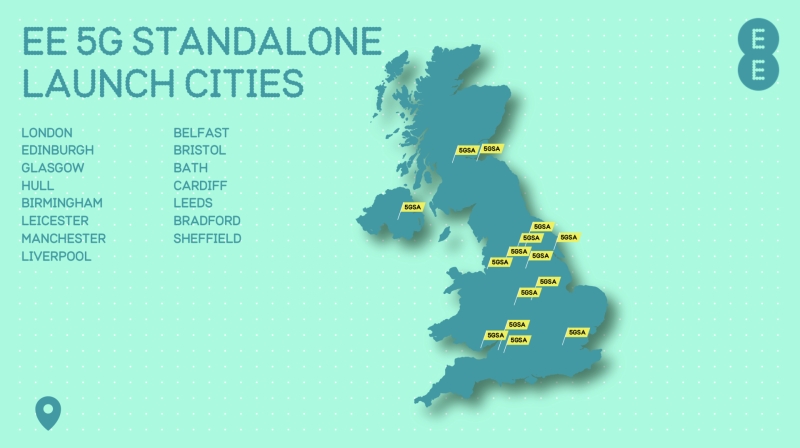
EE has taken the next big step in mobile connectivity, as it has switched on its 5G Standalone network.
This long awaited upgrade should allow EE to deliver on the full promise of 5G, where previous technology (5G Non-Standalone) couldn’t.
For more on what exactly EE’s 5G Standalone network is, what benefits it brings, and how to use it, read on.
What is 5G Standalone?
5G Standalone means a 5G network that’s built from the ground up for 5G, rather than relying in part on legacy 4G infrastructure.
Most 5G networks in the UK currently are the latter, and as a result they can’t deliver on the full potential of 5G.
With 5G Standalone, you can expect higher speeds, lower latency, and greater capacity, which should ensure more reliable performance, even in busy areas such as stadiums and train stations. It can also improve indoor coverage and battery life.
EE claims that its 5G Standalone network is up to ten times faster than 4G, and that it can deliver better gaming and video streaming performance than 5G Non-Standalone.
EE says that its 5G Standalone service has also been designed to smoothly run future AI applications, and indeed this network is powered by AI technology, using automation for example to improve network reliability and using machine learning to reduce the energy demand, by putting cells into a sleep mode when they’re not being used.
Where is EE 5G Standalone available?

At launch, EE’s 5G Standalone service was available in 15 locations, including Bath, Belfast, Birmingham, Bradford, Bristol, Cardiff, Edinburgh, Glasgow, Hull, Leeds, Leicester, Liverpool, London, Manchester, and Sheffield.
Since then, it has come to more locations, accounting for over 34 million people, which is more than 50% of the UK population.
EE hasn’t provided a full list of locations, but has named the following as being among them:
Ashton-Under-Lyne, Altrincham, Barrow-in-Furness, Barry, Bath, Belfast, Birkenhead, Birmingham, Blackburn, Bradford, Bridgend, Bristol, Bury, Caerphilly, Cardiff, Corby, Coventry, Cwmbran, Doncaster, Dudley, Dundee, Edinburgh, Exeter, Glasgow, Huddersfield, Hull, Hyde, Leeds, Leicester, Liverpool, London, Manchester, Middlesbrough, Milton Keynes, Newport, Nottingham, Port Talbot, Rotherham, Sale, Sheffield, St Helens, Stockport, Sunderland, Swansea, Wakefield, Walkden, Weston Super Mare, Wigan, Wilmslow, Wolverhampton, Aberdeen, Beverley, Blyth, Boston, Canterbury, Chippenham, Cleethorpes, Crawley, Derby, Exmouth, Great Malvern, Grimsby, Halifax, Harlow, Havant, Inverness, Ipswich, Leyland, Lichfield, Loughborough, Norwich, Paignton, Peterborough, Royal Leamington Spa, Salisbury, Shrewsbury, St Albans, St Neots, Sutton in Ashfield, Trowbridge, Wellingborough, Whitley Bay, Windsor, Winsford, Wishaw, Wokingham, Wrexham, Yeovil, Carlisle, Chesterfield, Hemel Hempstead, Newcastle-under-Lyme, Gosport, Slough, Stoke-on-Trent, Sutton Coldfield, and York.
EE claims that its 5G Standalone is “the first of its kind in the UK to offer near uninterrupted outdoor coverage in every city where it launches.” So it should be widely available in the locations above, with EE only announcing availability once there’s at least 95% outdoor coverage in an area.
Looking ahead, EE has also said it will switch on 5G SA in the following 17 places by the end of 2025:
Basildon, Bolton, Brighton and Hove, Colchester, Gloucester, Lincoln, Maidstone, Newcastle-upon-Tyne, Northampton, Oxford, Plymouth, Poole, Portsmouth, Reading, Southampton, Southend-on-Sea, and Telford.
Which plans include 5G Standalone?
5G Standalone now comes as standard for all new and upgrading customers taking any EE handset plan. Prior to March 2025 though, you needed one of the network’s top plans, namely an All Rounder or Full Works plan, purchased on or after August 29, 2024.
Which phones work with EE 5G Standalone?
EE has said you’ll need a compatible phone to access EE 5G Standalone, but hasn’t listed which phones that includes.
However, it’s likely to be a similar selection to those supported by O2 and Vodafone’s 5G Standalone services.
That would mean the likes of the Samsung Galaxy S25, Samsung Galaxy S25 Plus, Samsung Galaxy S25 Ultra, Samsung Galaxy S24, Galaxy S24 Plus, Galaxy S24 Ultra, Galaxy S23, S23 Plus, S23 Ultra, Galaxy S22, S22 Plus, S22 Ultra, Galaxy S21, S21 Plus, S21 Ultra, Samsung Galaxy Z Flip 6, Galaxy Z Flip 5, Samsung Galaxy Z Fold 6, Galaxy Z Fold 5, Google Pixel 9, Google Pixel 9 Pro, Google Pixel 9 Pro XL, Google Pixel 9 Pro Fold, Google Pixel 8, Pixel 8 Pro, Pixel 8a, and perhaps others.
Indeed, while EE hasn’t provided a list, it has said that there are phones from Apple, Samsung, Google, Motorola, Nokia, TCL, and Honor that support its 5G Standalone service.










